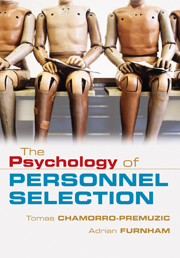Book contents
- Frontmatter
- Contents
- List of boxes
- List of figures
- List of tables
- Prologue and acknowledgements
- Part 1 Methods of personnel selection
- 1 Early, unscientific methods
- 2 The interview
- 3 Letters of recommendation
- 4 Biodata
- 5 Situational judgement tests and GPA
- Part 2 Constructs for personnel selection
- References
- Index
3 - Letters of recommendation
from Part 1 - Methods of personnel selection
Published online by Cambridge University Press: 05 June 2012
- Frontmatter
- Contents
- List of boxes
- List of figures
- List of tables
- Prologue and acknowledgements
- Part 1 Methods of personnel selection
- 1 Early, unscientific methods
- 2 The interview
- 3 Letters of recommendation
- 4 Biodata
- 5 Situational judgement tests and GPA
- Part 2 Constructs for personnel selection
- References
- Index
Summary
Introduction
Another widely used method in personnel selection is the reference report or letter of recommendation, simply know as the reference, whereby a referee (e.g., former employer, teacher or colleague) provides a description and usually, but not always, a statement in support of a candidate or job applicant (see Figure 3.1 for an example). Thus referees are expected to have sufficient knowledge of the applicant's previous work experience and his or her suitability for the job applied for.
References are almost as widely used in personnel selection as the interview (see Chapter 2). The Price Waterhouse Cranfield (Dany & Torchy, 1994) review of assessment methods (see Figure 3.2) found that the vast majority of employers in Europe use references to inform their hiring decisions (especially in Scandinavia and the UK) (Lévy-LeBoyer, 1994), with US estimates (Burean of National Affairs, 1988; Judge & Higgins, 1998; Muchinsky, 1979a, 1979b) similar to UK ones. Yet there has been a surprising dearth of research on the reliability and validity of the reference letter; and, as shown in this chapter, an assessment of the existing evidence suggests that the reference is a poor indicator of candidates' potential. Thus Judge and Higgins (1998) concluded that ‘despite widespread use, reference reports also appear to rank among the least valid selection measures’ (p. 207).
- Type
- Chapter
- Information
- The Psychology of Personnel Selection , pp. 52 - 61Publisher: Cambridge University PressPrint publication year: 2010



